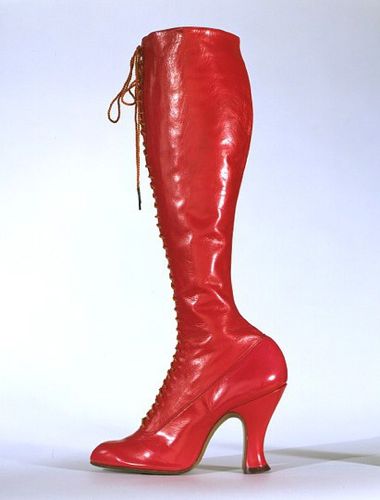Some vintage items really challenge our cultural perceptions of an era. Take these boots.
We think of the Edwardian women as status and propriety bound carryovers of the Victorian era, clad in layers of white and pastel frills, and encouraged to be eminently retiring and delicate and feminine. These boots turn all of that on its head. They are feminine, that’s for sure, but there is nothing retiring, pastel, or frilly about them!
They are so loud, and high, but the lack of ornamentation is also very elegantly restrained. And the curves! They are basically the shoe version of Camille Clifford’s figure!
Can you imagine the sensation that Camille would have cause if she had worn these? My legs certainly don’t have the right curves to pull them off!
I wonder who did wear them, or what market they were intended for? Perhaps they were the sort of shoes that ‘nice’ women would never consider.
Hehe, turn-of-the-century slapper boots!


Ah but they would have been hidden by a long skirt… how delicious that might have made her feel! I mean, people could mistake her for a nice girl – depending upon what else she wore of course. I visited the V&A just last week and their fashion department is closed for another year or so for refurbishment – quite disappointing but well done for finding the photograph.
These are great. At the LACMA exhibit currently showing, Fashioning Fashion, there are black boots like this and some Edwardian fetish boots which are amazing! The fetish boots have two sets of laces up the front and a red leather tongue.
Wow- those are something! They do look like Camille Clifford’s figure!
But RED! That’s pretty cool.
Remind me of the boots I saw at LACMA at the Fashioning Fashion exhibit. There’s a picture on this blog:
http://wanderlustnpixiedust.typepad.com/wanderlust_pixie_dust/2010/09/fashioning-fashion-exhibition-at-lacma-european-dress-in-detail-1700-1915latimescom.html
Fetish boots! They always fascinate me because they’re so modern (yet not). I’ve read there was a big industry in Germany for fetish wear, boots among them, the clientele being, well….
I would ask whether they show any signs of being worn. Looking at the size of the ankle relative to that of the back of the shoe (not parts which are known for being squishable) These boots look anatomically unlikely.
I’m not sure if these have been worn, but I have seen boots with similar shaping that were worn (Te Papa has some), so I know it was done.
The Victorians were obsessed with trim ankles, and one way to make the ankle look small was to exaggerate the size of other parts of the foot. Also, feet used to be a different shape – they spent so much time in restrictive shoes that they were much narrower, so it’s possible that other parts were compressed and reshaped.
They are an amazing shape, and quit vavavoom. But for a leg to fit them, it must have been pretty odd looking!
Wow!
Wow these are fantastic, what a great colour. I did not know they were so naughty – how delicious!
While waiting interminably for our brunch this morning, I noticed a print of Toulouse Lautrec’s poster for can can dancers – “La Troupe de Mlle Eglantine” and they are wearing the exact same shaped black boots! I knew I’d seen them somewhere 🙂
http://www.toulouse-lautrec-foundation.org/La-Troupe-De-Mlle-Eglantine.html
A late comment on this blog entry:
The museum information state that they are signed as expressly made in Belgium for National Shoe Stores, London. I have a same pair, maybe a few years younger, in black from the same maker/seller. National Shoe Stores located in London inserated regularily in the magazine “London Life” during the 1930’s. I have a few issues of these magazines with an add. Interesting is that the advertisement says: “High-Heeled Shoes & Boots, Sizes One to Eleven in Stock, Up to 9 Inches…” So it seems there was aslo a fetishistic interest back then.
London Life itself had interesting photographs and stories from readers about high heel shoes and boots.